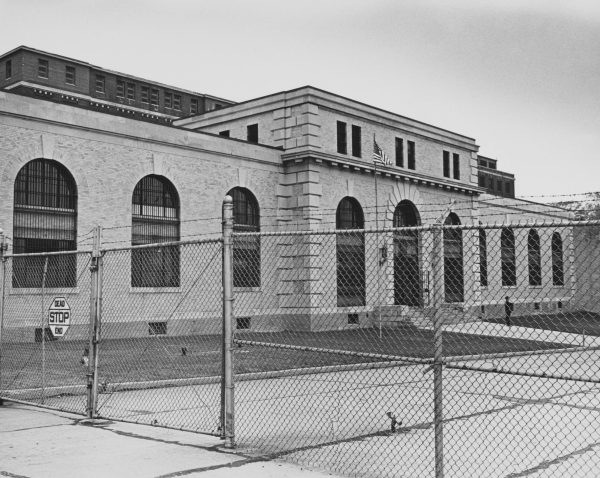
There is a cognitive dissonance associated with the products used in our daily lives and their origins, especially in the production process. Products from campus furniture to hand sanitizer that students use throughout their college experience are rarely looked at through a critical lens. This lack of discernment erases the reality that these products were made using prison labor.
Corcraft is a state-run program within the New York State (NYS) Department of Corrections and Community Supervision. It operates as a manufacturing and service entity that uses incarcerated individuals as its laborers within the state’s correctional facilities. The program produces a wide range of products, including furniture, clothing, license plates and cleaning supplies such as hand sanitizer.
While the program aims to offer vocational training, work experience and opportunities for skill development to inmates, it’s hard to believe that learning how to make hand sanitizer and license plates can prepare an incarcerated individual for the real world.
Wilfredo Laracuente was an unwilling participant in the Corcraft program during his time serving 20 years at Sing Sing Correctional Facility in Ossining, N.Y. Laracuente described the labor conditions encountered as unproductive for rehabilitation.
“Would you rather have the bitterness of 15, 20, 25 years of hard labor, or would you rather invest in their psyche?” Laracuente said at a teach-in held at Stony Brook University on March 25.
Laracuente even described an instance where incarcerated workers weren’t able to use the hand sanitizer they had manufactured since it had alcohol in it. However, more startling was his observation on wages.
“Your license plate was made by someone who was paid 15 to 45 cents per hour,” Laracuente said.
Factoring in the abysmal wages received — a whopping starting wage of 16 cents an hour in NYS with a 65 cents per hour salary cap — and the exponential profits reaped by the state, it’s clear that this program is meant to be a cost-saving initiative for NYS.
According to a Freedom of Information Law (FOIL) request submitted by Stony Brook Associate Professor Robert Chase, Stony Brook was ranked third for purchased Corcraft products in 2019 — totaling $39,086 for both the University and Stony Brook University Hospital. SUNY Central Administration topped the list with $316,168 spent.
That number has since significantly dropped for Stony Brook. In a FOIL submitted by The Statesman, between the 2022-23 fiscal years, Stony Brook spent $4,972 on new chairs for the Ambulatory Surgery Center at Stony Brook University Hospital. According to those records, the fiscal year of 2023-24 shows no purchases on behalf of Stony Brook or the hospital.
“Over the past three years, Stony Brook University has spent 0.04% of its total furniture spend on Corcraft products, and Stony Brook Hospital has spent 0.60% of its total furniture spend on Corcraft products,” Senior Director of Stony Brook Media Relations Kelly Drossel said on behalf of Stony Brook officials.
But that does not mean that these purchases will not continue in the future. In fact, deciding which vendor to use isn’t necessarily up to the SUNY schools, but NYS.
“As part of the SUNY system, Stony Brook University is legally required to purchase certain goods and services from preferred state suppliers, which include Corcraft,” Drossel said.
Corcraft is a preferred NYS vendor. This means that state institutions like SUNY schools are legally required to purchase from these preferred vendors due to procurement laws, regulations and statutes that govern the process by which government agencies acquire goods, services or works from external suppliers or contractors.
In fact, Corcraft is the top preferred vendor over non-profit making agencies for the blind and disabled veterans. Curiously, 50% or more of allocated work goes to Corcraft since they are the first choice according to NYS.
Why would a prison labor operation beat nonprofits that provide work for some of the most vulnerable members of our society? The answer is profit.
Chase’s 2019 FOIL revealed that NYS made $53 million in 2017 off of Corcraft contracts, which goes directly into the state fund. These cost-comparable prices of furniture and other products are made possible by the low wages prisoners receive. Essentially, it leaves a monopoly on taxpayer-funded furniture leaving many other businesses — both large and small — outside of the bidding conversation.
History of convict leasing
An argument may be presented that it is only right that prisoners produce labor in exchange for serving out their respected crimes. However, the history of prison labor has deep and broken roots relating back from the transition of slavery to convict leasing — a practice in the Antebellum South during the Reconstruction era where men convicted of crimes were leased out by the state to private companies for labor.
Photos of Black men picking cotton in striped apparel may incite the average person’s brain to think the practice’s history resides in the era of slavery. But the striped apparel is prison garb, made possible by the little clause under the 13th Amendment that the prohibition of slavery did not apply to those convicted of a crime.
This exception created an industry. New laws in the Reconstruction era held vague guidelines such as vagrancy and loitering, which meant that Black men and women could be arrested at the drop of a hat by a money-hungry crime hunter’s interpretation of the law; these individuals would receive pay for every ‘criminal’ apprehended.
It was a lucrative exchange between private companies and state governments. No wages were required for prisoners, so company profits soared and convict lease industries would then pay out leasing fees to state, county and local governments in exchange for the prisoners.
The convict leasing system was seemingly dismantled in Southern states in the early 20th century. But the reality is that this system transformed into something else altogether, trading the economic power and profit from private industries to the state. This results in the state-run chain gang supplementing the state’s personal budget.
Why does it matter?
Abandoned at birth in a hospital, Rosemary Rivera described her mother and father as the state of New York. Like many other children who end up in the state system, Rivera was subjected to numerous injustices that led to a life on the streets as a prostitute, hooked on drugs. This lifestyle led to her eight-year incarceration and subsequent work at Corcraft.
“We would wake up, have breakfast and go to industry for Corcraft,” Rivera said. “There was welding and that was dangerous. Also industrial painting with hazmat-like suits and you have to lift heavy items and do dangerous work.”
Now, Rivera is the Executive Director of Citizen Action of New York, a leading committee for the state organization 13th Forward — a legislative coalition working to end exploitation in New York’s prison system. However, when she first arrived in Albany, N.Y., Rivera explained that she refrained from explaining to people that she was formerly incarcerated so that they would take her seriously.
The stigma associated with incarceration suggests that many individuals would turn a blind eye to this injustice occurring in our seemingly democratic state. Our prisons are tucked away in isolated parts of upstate New York, out of the sights of the majority liberal populace in New York City. Although there are nearby jails such as Rikers Island, these are transient facilities that serve to hold prisoners that have short sentences and then send incarcerated individuals to prisons upstate.
This geographic isolation makes it easy for us as students to dissociate from the realities of production of classroom products. But that does not take away from the hard and meaningless labor incarcerated people face.
Let’s say you are in an upstate prison for 40 years. You spend your rehabilitation making license plates, chairs and hand sanitizer for the maximum amount of 65 cents an hour. Working 40 hours a week, you’d make $54,080 over the course of your entire sentence.
That does not account for the fact that your starting wage would be 16 cents and that you are financially responsible for phone calls and hygiene products outside of what the state is legally required to provide: “soap, a toothbrush, toothpaste, a drinking cup, toilet paper, a bath towel and tampons and sanitary napkins to women.” Ironically, the sanitary napkins provided by NYS is a relatively new thing, according to Rivera, as they were not provided during her incarceration.
All-in-all, by the end of your prison stint, that income would decrease significantly.
If you have been in prison for 40 years and re-entered society in your 60s or 70s, are you expected to continue to work? Who will hire you with a criminal conviction on your record? How will you afford shelter, food and other basic necessities?
This argument may not tug at your heartstrings as much as how the use of state-run convict labor takes away opportunities from the working and middle class.
The fact that Corcraft has priority over non-profit organizations that provide labor to the blind and disabled veterans should sound off alarm bells in your head. What about small businesses and unions that produce furniture? When convict leasing was rampant in the South, it was labor unions who called for its end due to the industry undermining competitive labor markets. Why should a private company pay a free man honest wages when they can use prison labor for close to free?
For instance, in 2020 after sanitation workers went on strike in New Orleans, La. over insufficient personal protective equipment and hazard pay, the strikers claimed they were fired. Instead, the sanitation company hired “Lock5, LLC to provide prison workers at a rate of $9.25 per hour. Lock5 receives 64% of those wages for expenses. Prisoners end up retaining about $1.33 per hour for their labor.”
If a labor union goes on strike for a perceived slight against the working and middle class, state institutions and state-run companies can turn to jails for labor. Since it is extremely profitable for the state fund, it is unlikely that NYS will ever turn away from this system.
Where we are now
After the murder of George Floyd in 2020, Stony Brook released a statement on May 30, stating, “we must stand up and speak out against injustice and ignorance. As a public institution of higher learning, we must use our power to address major societal problems.” If that is the case, then why has there been little to no comment on the relationship between SUNY universities and prison labor?
The use of prison labor is one of the biggest societal injustices since the Emancipation Proclamation was spoken by then-President Abraham Lincoln as he called for an end to slavery. This practice of insourcing is not only exploitative but lacks the necessary skills that prisoners need when they are released from prison.
Stony Brook Professor of Africana Studies Patrice Nganang said it best at the University’s prison labor sit-in event this year on March 25: reparations are needed if Stony Brook administrators truly feel aligned with their statement from 2020.
Nganang outlined what he believes is the best approach for Stony Brook:
- Stony Brook should admit that they have committed this “crime” and provide acknowledgement in written form.
- Stony Brook should apologize to the people who have been wronged; this is a matter of dignity, not just numbers.
- The University only has around 1,600 Black students. Stony Brook needs to address this and they need to have fellowships and scholarships available for Black students.
- They should incorporate education for prisoners to repent for the labor they exploit.
If Stony Brook cannot get out of the confines of NYS’s vendor system, then they should be speaking up about it alongside other SUNY schools. Not only is this system detrimental to the prisoners, but it is taking away opportunities from other working-class people to participate in these state contracts.
















